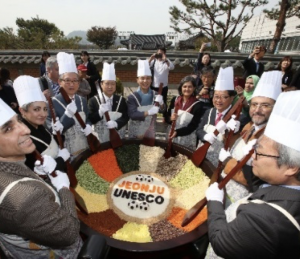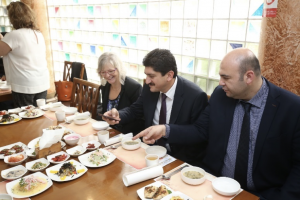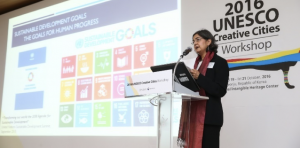Soft Power
Now that we have taken some time to explore cultural values as well as cultural value, we will now discuss their link to the concept of soft power. Going back to the root of the term, power refers to the “ability to affect others to get the outcomes one prefers” (Nye, 2017, p. 1). This can be accomplished in a variety of different ways. In 1990, American scholar Joseph Nye broke down the concept of power and coined the term soft power, which refers to the ability to use one’s influence in order to obtain a favoured outcome, as opposed to using coercive measures linked to the notion of hard power. Hard power as we understand it today includes things like military or economic might, whereas soft power includes utilising aspects of a culture that are appealing to others, ultimately leading to a willingness of others to sympathise with or adopt one’s views (Foreign Policy Association, 2016). As Papaioannou notes, “this attractiveness rests on intangible resources, such as culture, ideology, and institutions, which could help to legitimise the power and policy of a given state in the eyes of others” (2018, p. 449).
As we mentioned earlier, culture is one of the three pillars of soft power that Nye identifies, along with political values and foreign policy decisions. While all three pillars can contribute to a country’s overall perception, cultural soft power differs from the latter two as it is not necessarily linked to government decisions (Foreign Policy Association, 2016). The cultural soft power pillar can instead include things that are more ‘organically’ developed such as nationally shared cultural values or cultural assets. From multiculturalism as a cultural value to museums as a cultural asset – there is power and influence in the many different aspects of culture.
UNESCO’s Creative City Network
Because this is all very conceptual, taking UNESCO’s Creative Cities Network (UCCN) (See Video 3:2 UNESCO Creative Cities Network) as an example will help us understand how the idea of soft power applies in real world situations. There are over 200 cities across the world with memberships to the UCCN. As UNESCO notes, cities that become a part of this network place creativity and cultural industries at the heart of their local development plans and actively cooperate with other cities in the Network (UNESCO, n.d.a). To gain membership, “candidate cities must submit an application that clearly demonstrates their willingness, commitment and capacity to contribute to the objectives of the Network” (UNESCO, n.d.c, para. 1). Members that join UNESCO’s Creative City Network commit to cooperating on an international level, and working to enhancing the creative potential of their city and the pursuit of sustainable urban development.
Video 3:2: UNESCO Creative Cities Network
There is a great deal of cultural value in our communities, and it is important to take the time to identify and celebrate what makes our communities unique, vibrant and sustainable. Let’s dive a little deeper and take a look at the city of Jenuju, South Korea as we explore this concept further. Jeunju is the Creative City of Gastronomy, and needless to say the culinary experiences throughout the city are wonderful, but Bibimbap is what has put them on the map (See Figure 4:3 Bibimbap Ceremony). The City of Jeonju supports the development a traditional food culture including cooking programs, and is home the Creative Culinary Institute of Korea and the Bibimbap Globalisation Foundation. They also host a number of food festivals such as the Jeonju Bibimbap Festival and the International Fermented Food Expo (UNESCO, n.d.b).

In 2016, I [Kelly Jerrott] had the honour of speaking at the UNESCO Creative City Forum in Jeunju, South Korea (See Figure 5:3 Kelly Jerrott, with representatives from Turkey experiencing traditional Korean foods).

I was inspired by the keynote address provided by the Director of the Division of Creativity for UNESCO, Ms. Jyoti Hosagrahar (See Figure 3:6 Jyoti Hosagrahar, Director of the Division of Creativity for UNESCO). Ms. Hosagrahar emphasised that culture, for the first time, is being referred to in UNESCO’s goals and targets for development as an essential and indispensable leader for achieving sustainability.

(Photo courtesy of the Korean National Commission for UNESCO)
The research conducted by UNESCO is a great resource for those who work in the cultural sector and if you have not had an opportunity to look at some of their resources such as the recent launch of the UNESCO Global Report on Culture for Sustainable Urban Development, Culture, we encourage you to check it out (See link 3:1 Culture for sustainable urban development).
Being named as an official Creative City by UNESCO is no small feat. There is a rigorous review and selection process, and you can be sure a city’s cultural value is included in the criteria. The designation can be leveraged by the local community to support economic, social and environmental development, helping to create more sustainable communities. When we leverage our collective inventory of cultural value to assist our communities in getting things done, we are using soft power.
Soft power in our local communities
Scaling this down, how does this apply to your work in engaging with your community? What would the practice of soft power look like on a microscopic level in your community or organisation? By definition, community engagement encourages a “strategic approach to relationships, communication and interactions between community members and organisations to try to influence outcomes for both” (Hendricks, 2021, para.1). Ngaire Blankenberg’s TEDx Talk in Hamburg (See video 3:3 Ngaire Blankenberg at TEDxHamburg) illustrates how institutions like museums can have soft power. In the talk, Blankenberg goes on to discuss how the influence of museums on our society can be both positive and negative. She highlights how some museums have previously been “instruments of exclusion” but are capable of changing in the modern world and suggests that there are ways in which we can harness their soft power and use them as “tools for inclusion” instead. As you watch this video, think about the kind of influence an organisation, perhaps even the organisation you work for can have within your community.
Video 3:3, Ngaire Blankenberg at TEDxHamburg
Now let’s think about this in terms of how our own personal/organisational values affect the way we develop relationships with our own colleagues. Each of us has our own ideology which impacts the way that we interact. If our colleagues find the way that we work appealing, they might be keener to work with us and listen to our opinions. While this is a more mainstream version of the concept, we can still very much see the characteristics at play. A number of examples of soft power on this level will be seen throughout the rest of the chapter.
